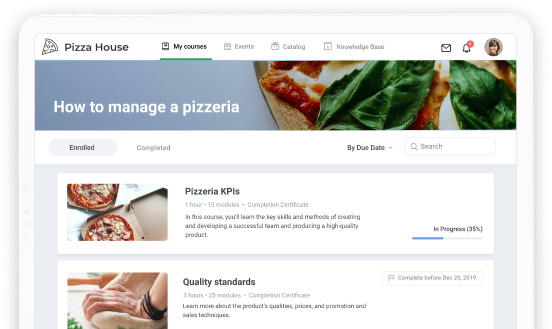Case Study: Part Time Training Courses

It’s time for the next installment of our Edge Hill University Case Study series! This time, we’ve transcribed the entire interview with an educator who was successfully able to integrate blended learning into her traditional classroom teaching. With iSpring, even part time training can be extended to be accessible for students anytime, anywhere.
Check out the previous iSpring Edge Hill University Case Study →
How to use iSpring for Part Time Training Courses
Maggie Webster is a Senior Lecturer in Religious Studies from the Faculty of Education. Find out how iSpring “motivated [her] to be more creative in [her] teaching” with its familiar PowerPoint interface and versatile toolkit:
Q: Tell us a little about yourself?
A: My name is Maggie Webster, I’m a senior lecturer in the Faculty of Education at Edge Hill University, and I teach a variety of programs, but mainly religious education and religious studies. I’m also a year leader for third-year part-timers; a lot of those trainees tend to be mature and part-time, so they do a lot of distance stuff, and they also come into university once a week. So, I have a selection of students, some of them mature, some of them who are undergraduates who are traditionally 18, etc., and they all have varying competencies with technology, and also various interests with it. So, I’m trying to reach a broad range of people when I’m teaching, if I can.
Q: What motivated you to consider iSpring?
A: Motivation came from the type of students I work with. Effectively, I have some students who need extra information. iSpring is quite handy because I can supplement extra information from what I do on a face-to-face [basis]. If I have, for example, part-time trainees, and they don’t have a lot of time on campus, I can give them the basics to start with, and if I need to add to it, then I will create an iSpring with a voiceover, and that means they can continue with that on their own as a distance learning.
Another thing that motivated me was with religious education in particular, on the undergraduate program, and post-graduate for primary. We don’t have many hours within the definitive course document. That’s normal across the whole nationals, not just unique to this institution; but it means, in that subject knowledge, in terms of what is religion, with the facts of Sikhism, and Hinduism, etc., it’s slightly lost. So I wanted to create something that was a subject knowledge package, that a student could do at home as well as then supplement what they do here in the form of blended learning. iSpring, I thought, would be a really good use for it, and I really liked the idea of the voiceover in particular. That motivated me to be more creative in my teaching, I think.
Q: What are the benefits of using iSpring?
A: I think iSpring is really useful because of its adaptability. It is something that, when you look at the interface, it looks very familiar, so it’s PowerPoint. It’s not difficult to use, and it’s something that can also be used — if you don’t have iSpring on your computer at home, you can still access it, which is quite handy — so it’s transferrable.
Although at first, I got a bit daunted about how to save it, I got a bit confused, and a bit worried, but Learning Services helped me with that, so then I got a bit more confident, and I thought, “Okay, I’ll have to take a risk.” And it was brilliant then, because I realized the potential of this software, that it’s not that scary to use, it’s something that is manageable, because it’s familiar, but also [with] saving, there’s a technique that you use, and then it’s done.
I can see the potential of it being useful for me as a user; I can do it with iSpring on my computer here, and I’ll have it at home as well, and it’s something that is easy to explore and improve on. There’s so many other features that I haven’t yet explored, that I’d like to have more opportunity to do, I think. I’ve only just touched the potential of it, which is quite exciting.
Q: What are some of the challenges?
A: With challenges, I think, the first time you think of something new, it’s always a bit scary, you’re thinking, “Oh, it’s a new technology, I have no time, I have a very busy life — I have a very busy home life, a very busy work life — how am I going to fit it in?” But with any form of technology, plug-in-and-play really helps, and that’s what this does. iSpring is something that looks like PowerPoint, feels like PowerPoint, and is effectively PowerPoint. And then there’s a few buttons that help you understand the features of it. You do need to spend a little bit of time, but it’s not the huge investment that we had to do years ago, just learning about how to do a spreadsheet, or how to do a PowerPoint in itself. It’s so much quicker, as most technology is now anyway. So I think, once you spend a few hours — an hour is all I spent at first, and then I could see the potential.
The publishing I had trouble with, so that frustrated me, and that took a bit longer, but then I found an expert to help me, and then I felt a lot happier, and that was great; Learning Services were very helpful then. Once I’d got that, I then thought, “Oh, I can fly with this.” So I tried one, and I tried another, and then I realized that there was a quiz tool, so I played with that, and that was quite exciting. And I know that there’s still more tools to play with. In the end, if you change your mindset, and think, “It’s not a problem,” you see it as an opportunity to play, and if you happen to like technology, then it’s really easy to do. And if you’re making a presentation anyway for your course, it makes sense to do it in this, because there’s more enhanced features. So I think that there’s not many challenges with it; it’s down to a mindset first, in my opinion.
Q: What is your outcome of the iSpring project?
A: Well, there’s been a lot, really. I think mainly that now, when I come to create a new session, I will automatically go in iSpring; I won’t go PowerPoint, because there are more features. I also now think about blended immediately, rather than do one or the other. The thing I get frustrated about sometimes is that we think blended learning or learning online is a repository of paperwork. I don’t think it is. I think it is actually an exploration of what you learned face to face and then what you learn online, so it has to transform what you do; it can’t just translate it. As a consequence, I think iSpring is really good at helping you make sure that what you do face to face is enhanced online.
One of the successes that I’ve enjoyed is that I did the online subject knowledge session, and then students did a quiz to see if they actually remembered it. It was quite useful, because students have said “Oh, actually, I’ve learnt lots from that.” It didn’t take them that long, because it helped them move to different websites. That’s an embedded feature, to take you straight to the website and to the particular page. When I’ve told them previously, “These are the websites you can go to to learn the subject knowledge,” they haven’t done it. iSpring has made them do it, and has made them then consolidate their learning through the quiz, and I quite like that. So that’s been very useful for me.
Q: Next steps?
A: I would like to explore more opportunities, some of the features. The quiz I like, but I think that’s just the tip of the iceberg. I haven’t really provided enough opportunity for me to invest in different ways of using iSpring in a creative way. I wanted to transform my teaching, not translate it, as I’ve said before, so I really want to think of ways of using it to be a collaborative project between students and myself. I will possibly do a voiceover again, and then possibly do quizzes again, but I would like students to think about how to use it as well, so that they can include iSpring in their presentations that they have to do; and possibly use it as a tool within my learning, not just as a distance now.
My session has an iSpring element to it with laptops, and I’ve already created the iSpring as a quiz against different groups, and then they just flight-test each other out, and see who got it, so it’s sort of like a game if you like. So there’s potential to this. I just want to do more, I think. I’m at the beginning, I’d like to go further with it. And that’s my next stage, really: explore more.
Conclusion: Using iSpring for Part-Time Training Courses
It was a great pleasure to see Maggie’s enthusiasm and dedication shine through in this interview, and no less a pleasure to learn how iSpring helps her transform her teaching into a powerful combination of face-to-face classroom sessions and self-motivated distance learning.
Stay Tuned!
We’ve got one more case study in store for you next week, so be sure to check our blog and find out how another Edge Hill instructor leveraged the power of iSpring to boost his training.
Would you like to participate in an iSpring case study? Do you already have some great iSpring stories to share? Tell us about it in the comments below!

